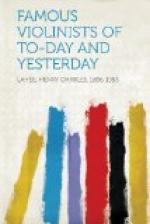To this period also belong a number of excellent violinists whose names are seldom heard in America. Edmund Singer, a Hungarian, born in 1831, by dint of hard work and talent reached a high position. He became celebrated as a teacher, and was for years professor of violin at the conservatory in Stuttgart. He was also largely instrumental in the establishment of the Musical Artists’ Society of that place.
Ferdinand Laub was a virtuoso of high rank who was born in Prague in 1832. He succeeded Joachim at Weimar, but two years later became violin teacher at the Stern-Marx conservatory in Berlin, also concert-master of the royal orchestra and chamber virtuoso.
Heinrich Karl de Ahna was an excellent artist, and was for some years second violin in the famous Joachim quartet. At the age of fourteen he had already made a successful concert tour, and become chamber virtuoso to the Duke of Coburg-Gotha. He then abandoned the musical profession and entered the army, fighting in the Italian campaign as lieutenant. After the war he returned to his profession, and became leader of the royal band in Berlin and professor at the Hochschule. He died in 1892.
Russia also produced an excellent violinist, Wasil Wasilewic Besekirskij, who was born at Moscow, and after a career as virtuoso in the west of Europe returned to his native city. He is the composer of some good violin music and has formed some excellent pupils, of whom Gregorowitsch is perhaps best known.
In England, John Tiplady Carrodus and the Holmes brothers attained high rank. Carrodus was a native of Keighley, Yorkshire. His father was a barber, and it was only by the most constant self-denial and incessant hard work that the boy succeeded in securing his education. He walked with his father twelve miles in order to hear Vieuxtemps play, and to take his lessons he walked each week ten miles to Bradford, usually getting a ride back in the carrier’s cart. He became a pupil of Molique, and eventually one of the best known violinists of England, where his character as a man was always highly respected.
Alfred Holmes was born in 1837 and his brother Henry in 1839. They appeared together at the Haymarket Theatre in 1847, but immediately withdrew from public life and continued their studies for six more years. In 1853 they again appeared in London, and then made a long concert tour through the north of Europe. Finally they settled in Paris, where, nine years later, Alfred died. Henry Holmes became the chief professor of violin at the Royal College of Music in London, and has been also active as a composer and editor of violin works.
Jacob Gruen, too, who was born in 1837 at Buda-Pesth, and who, after a career as concert soloist in Europe, became a teacher in the Vienna conservatory, should not be forgotten. Several of his pupils are now holding valuable positions in the United States, and he is an excellent teacher, besides being popular and kind-hearted.




